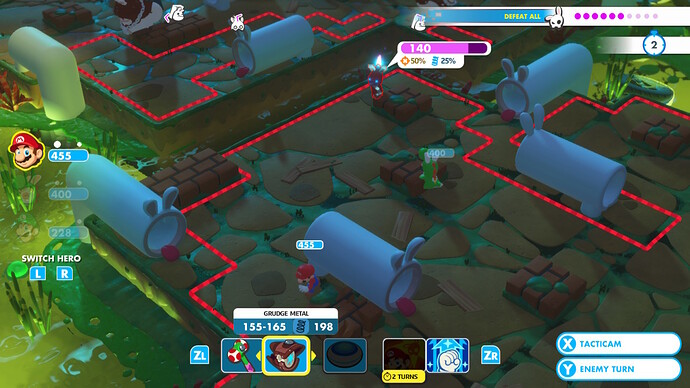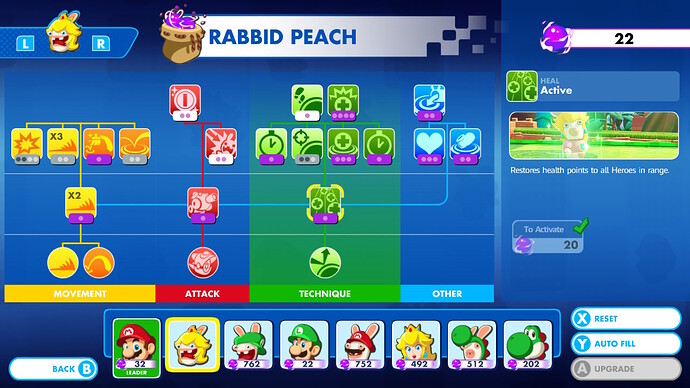Originally published at: http://statelyplay.com/2017/10/02/review-mario-rabbids-kingdom-battle/
Switch •
I like to imagine that Mario + Rabbids: Kingdom Battle was pitched by the most dependable, sober person at Ubisoft. You may have heard that it’s mostly XCOM, but with much less uncertainty and with some light puzzling elements replacing base management. Add a manic, child-friendly theme and remove permadeath, and that’s pretty accurate, which makes me think that pitch involved a virtuoso in the projection of normalcy. The characters are pre-made (so I can’t do what I’ve long done with XCOM and learn my kids’ classmates names by assigning them to my soldiers*) [I, on the other hand, change all my soldiers to British redheads named Amy Pond. It’s a bit weird. -ed.] but they have distinct skills trees which allow them to specialize in quite varied ways. Consequently, you have a lot of freedom to build the tools you want, but the game is correspondingly free to offer rather off-the-wall challenges.
This paragraph is probably unnecessary at Stately Play, but since comparisons with XCOM are so useful in thinking about M+R:KB, I feel compelled to offer some context. XCOM is a famous old turn-based tactical battle game which got a surprisingly slick update five years ago, and has since become a strong series. Players take control of the global resistance to an alien invasion, which involves a layer of Football Manager-esque choices about which squad members to rest, what technologies to develop, which missions to accept, and what extensions to build for your base. But most of the game is spent in particular missions with various objectives and which usually involve killing lots of aliens. XCOM is famous for punishing the reckless and thereby teaching players to use cover, set up overwatch (which allows members of your squad to take reaction shots during the aliens’ turn), and develop a deep enough bench to accommodate the death or injury of numerous squadmates. Because of the difficulty and the unpleasantness of the aliens, it’s not terribly child-friendly.
[caption id=“attachment_3244” align=“aligncenter” width=“1280”]
I have a 50% chance to hit the anthropomorphic rabbit ghost, but a 25% chance of a critical which would bounce it into the swamp of glowing ooze.[/caption]The thing about XCOM is, everything that makes it child-friendly is inessential to the basic gameplay. You can have turn-based shooting with a squad that uses cover and a variety of weapons and powers without complicated modifiers to hit percentages, hidden enemy unit deployment, creepy aliens, tragedy, or the possibility of digging yourself into a hole you can’t escape. XCOM and its children, like Hard West, have tended to aim for an adult audience, but kids are perfectly capable of grasping the basic concept. Indeed, I feel only a little bad about letting mine watch me play XCOM many times. They loved it, and seemed to understand what was going on far better than I’ll ever understand cricket. My son was delighted to discover a LEGO Ninjago set with a cobra-headed serpentine, because it could serve as a Viper enemy for his custom LEGO XCOM squad. A LEGO AT-ST did Sectopod duty. I point these things out, not only as an admission that I’m a terrible father and person, but also to explain why XCOM for kids is much less absurd than the presentation of this particular game makes it seem.
So, without all that base management, M+R:KB ties its battles together with a light exploration element with some puzzles roughly similar to what you might see in Skylanders or Tomb Raider. It ain’t The Witness, but it only gets irksome when you’ve found almost all of what you’re looking for. Then it’s like being on your way out the door and hearing from your child that they can’t find one of their socks. You look all the sensible places, because you’re sensible, but if they were in a sensible place, you’d have found them already, so you start looking in ridiculous places, because you’ve ruled out anything sensible, but then you’re always feeling ridiculous for looking in places like under the couch cushions or behind the toilet. Yes, I have found my children’s socks in these places [I’ve found my children in these places -ed.].
[caption id=“attachment_3243” align=“aligncenter” width=“1280”]
You ever feel like the best things in games are trees? Skill trees, tech trees, decision trees–all awesome.[/caption]The biggest innovation during the battles is the movement. Your units can do a small amount of melee damage by running through enemies within their range of motion, but this doesn’t cost any mobility–anywhere you could otherwise reach, you still can (indeed, if an enemy occupies a choke point, this makes the area behind that enemy accessible). Stranger still, you know how Mario games often let you jump on enemies to damage them? This one lets you jump on allies to bounce farther. Consequently, turns often involve considering various options for which character to move first in order to set up a jump for a later character to reach a flanking position, or to traverse a cliff which would otherwise bar movement. With different characters able to unlock increased movement-based damage through more dash attacks or direct damage following a jump, optimizing your choices gets complicated fast.
Fortunately, in addition to the main storyline, each of the four worlds offers optional challenges which are unlocked once you complete that world. The only piece of strategy advice I’ll offer is to try these challenges early. In the first, easy worlds, they offer a wider variety of demands, and really push the puzzle element of the game. They also yield money and power orbs which you can use to buy better weapons and progress through the skill tree. While money isn’t really much of an issue for a careful player, skills are relentlessly tempting sirens. They not give you the power to overcome a few bad moves in even the hardest story missions, they give you autonomy to develop new options which suit your methods. I pumped up Luigi’s overwatch ability as soon as I could, and it gave me tremendous satisfaction to watch him blast some cretinous rabbit-based threat into the air and then hit it twice more before it even hit the ground. He was admittedly quite the glass cannon, but what a cannon!
[caption id=“attachment_3241” align=“aligncenter” width=“1280”]
The mirror/laser puzzle makes it look like the game is desperate to do something that’ll seem normal and familiar.[/caption]What I notice, now that I’m nearing the end of the final challenges, is that everything bizarre about M+R:KB’s presentation and context masks a game which isn’t really that unusual. It’s very good, and even on the level of mechanics and level design is innovative enough to merit praise, but it doesn’t bend the mind too far. There are puzzles which require that you consider what you’ve been given flexibly, rather like those situations in which you must stop thinking about other people as rational agents and start thinking of them as heat sources or mass (I was a philosopher, so various trolley problems come to mind), and the final challenges are ludicrously hard, but that’s not particularly unusual for a game with a good dealing of puzzling. For many of us, what will seem most distinctive about the game is the user-friendliness of the Switch hardware and the fact that we can finally play a tactical battle game in front of our kids. At least, I assume some of you haven’t been doing that all along.
https://youtu.be/3bvUwoBXOyc*: I highly recommend this practice, by the way. It’s possible to cultivate a degree of subconscious respect for children when you associate them, even in ways you know to be irrelevant, with precious and capable specialists. Also, sometimes the wayfarer-sporting veteran medic or lightsaber- fusion blade-wielding ranger with 33 confirmed kills will call to invite your eight-year-old to the zoo.


